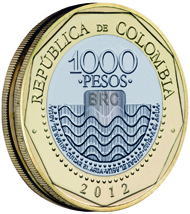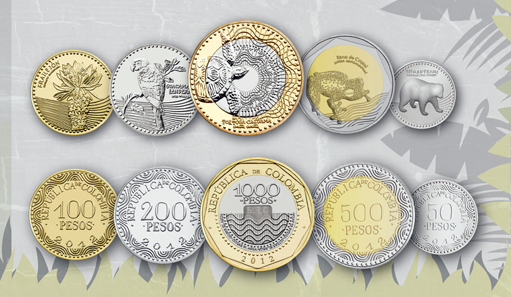October 16, 2012 – The Banco de la República de Colombia has issued a new and extended family of coins. The highest unit – the 1,000 Peso – has returned to the fold after an absence of ten years, with the intention of replacing the 1,000 Peso banknote. The new coins are lighter and, in most cases, smaller than their predecessors – making them cheaper to produce, according to the Bank, as well as cheaper and easier to manage in circulation. Moreover, they have a range of new security features, along with intricate design and engraving, to make counterfeiting more difficult.
The Colombian Peso was introduced as the official currency in 1837, and the present system of valuing the Peso at 100 centavos was adopted in 1872. However, during the latter part of the 20th century, the value of the centavo was eroded by inflation of such high levels that it now only exists in theory. Although the Bank proposed the redenomination of the Peso in 2010, by dropping three zeros, such a plan has yet to see the light of day (although a new plan is in the process of being submitted to the country’s Parliament).
The 1,000 Peso coin has been re-introduced with new security features since it was once heavily counterfeited. Courtesy of the Central Bank of Colombia.
Today, the coins issued by the Bank are the 50, 100, 200 and 500 Peso (there are lower value coins still in circulation, albeit that these are hardly ever used). The new series keeps these four denominations and re-introduces the 1,000 Peso. This was first issued in 1996 to circulate alongside the 1,000 note. However, it was heavily counterfeited and the Bank stopped its production in 1998. The security features on the new 1,000 Peso will make this less likely to happen, says the Bank.
The new series of the Colombian Peso. Courtesy of the Central Bank of Colombia.
The coins in the existing series have different design themes, reflecting their successive introduction during the latter part of the 1980s and the early 1990s. By contrast, there is a consistent design theme through all five coins in the new series of native Colombian fauna and flora, which is intended to reflect the country’s biodiversity. The coins also feature images of water, which is seen as essential to the country’s ecological heritage.
The best example can be seen in the new 1,000 Peso, featuring an image of a loggerhead turtle entering the water. The water is depicted by a series of undulating lines engraved at different depths. These are on a background of straight lines in which the word ‘agua’ (water) is repeated in microtext, every other word being inverted.
Another series of undulating lines appear on the reverse of the coin, beneath the denomination numeral. These lines incorporate the phrase ‘cuidar el agua’ (take care of the water) in microtext. Above this feature, and beneath the numeral, is a latent image that switches from MIL (thousand) to BRC according to the viewing angle. The reverse also features the wording ‘Republica de Colombia’ and the year of issue.
Additional security is provided by the bimetallic composition (gold-coloured on the outer, silver on the inner) and on the edge details, comprising striations which are bisected by a ‘security channel’.
A bimetallic construction has been retained for the 500 Pesos, this time with a gold coloured centre and silver outer. A crystal frog (from the Piedemonte area in the Andes) has been chosen as the main image on the front, beneath which is another series of undulating lines. These are also used on the reverse of the coin, around its outer edge. The rim of the 500 is a combination of striations and plain sections.
The 200 Pesos (a copper/zinc/nickel alloy) features a scarlet macaw, the brass-plated 100 Pesos coin a Frailejon plant (unique to Colombia, Venezuela and Ecuador) and the nickel-plated 50 Pesos an image of the spectacled bear – the only species of native bear in South America.
As with the 500, each has a similar theme on the reverse – the denomination numeral, the name of the country, undulating lines around the outer edges and the year of issue. The 200 Pesos has lettering on the rim, while rims of the 100 and 50 Pesos are plain.
The coins were designed by the Colombian artists Johana Calle and José Antonio Suarez and produced by the Bank, which has recently upgraded the production facilities at its mint and printworks. They are all now in circulation and will co-circulate with the existing coins, which will remain legal tender.
| Diameter (mm) | Weight (g) | Composition | |||
| Old | New | Old | New | ||
| 50 Pesos | 21.00 | 17.00 | 2.00 | Ni plated steel | |
| 100 Pesos | 23.00 | 20.30 | 5.31 | 3.34 | Brass plated steel |
| 200 Pesos | 24.40 | 22.40 | 7.08 | 4.61 | White CuNiZn |
| 500 Pesos | 23.70 | 23.70 | 7.14 | 7.14 |
Centre: CuAlNi |
| 1,000 Pesos | – | 26.70 | – | 9.95 | Centre: White CuNiZn Outer: Yellow CuNiZn |
More information on the Colombian coins and banknotes is available at the website of the Central Bank of Columbia.
You should visit the website of Currency News for more information or if you wish to subscribe to their excellent newsletter. Beside this article you can read in the current October issue many intriguing articles. Maybe some examples may arouse your interest:
- Cash Disrupted in Sweden as Panaxia Goes Bust
- ‘Better Than Cash Alliance’ to Push for Electronic Payments
- Nanoparticle QR Code for Banknote Authentication
- Mexico Introduces Low-Cost Banknote Denominator
- LOOK – One Marking Technique, Multiple Features
- Comment: The Vulnerabilities of Cash
- On the Record: Nigeria Goes for Currency Restructuring – or Does It?
Currency Publications Ltd, a joint venture between Reconnaissance International and Currency Research and publishers of the industry newsletter Currency News is organising the 2nd CoinConference in Berlin 2013. To learn more about this event, please click here.






